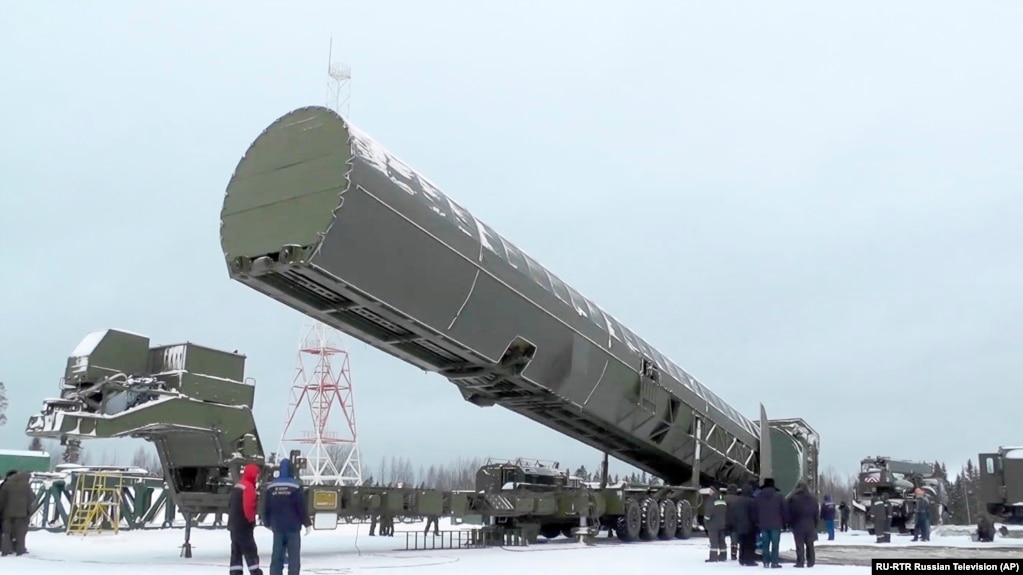World powers slightly reduced their stockpiles of nuclear warheads to 14,465 at the start of 2018, driven by cuts by United States and Russia, although modernization programs are continuing, a new report shows.
Stockholm International Peace Research Institute (SIPRI) on June 18 said the overall number of nuclear weapons held by the nine known nuclear powers was down from 14,935 the previous year.
The United States and Russia, despite the slight declines in their arsenals, still account for nearly 92 percent of all nuclear weapons, the group said in its 2018 yearbook.
“Despite making limited reductions to their nuclear forces, both Russia and the USA have long-term programs under way to replace and modernize their nuclear warheads, missile and aircraft delivery systems, and nuclear-weapon production facilities,” SIPRI said.
“The USA’s most recent Nuclear Posture Review (NPR), published in February 2018, reaffirmed the modernization programs and approved the development of new nuclear weapons,” it added.
It said the U.S. review emphasized expanding nuclear options to deter and, “if necessary, defeat both nuclear and nonnuclear strategic attacks.”
At the start of this year, the United States had some 6,450 warheads, down from 6,800 a year earlier, while Russia had 6,850, a decline from 7,000.
The institute attributed the declines to the two countries' actions pursuant to the implementation of the 2010 Treaty on Measures for the Further Reduction and Limitation of Strategic Offensive Arms (New START).
Nine states are believed to possess nuclear weapons. In addition to the United States and Russia, they are Britain, France, China, India, Pakistan, Israel, and North Korea, SIPRI said.
It estimated that Pakistan has 140-150 warheads, while India has 130-140. North Korea, it said, likely has 10-12.
Pyongyang, it said, continued to make technical progress in developing its nuclear weapon capabilities, “including the test of — what was claimed to be — a thermonuclear weapon.”
U.S. President Donald Trump and North Korean leader Kim Jong Un met on June 12 in a historic summit, with the leaders issuing a joint statement afterward committing the sides to the complete denuclearization of the Korean Peninsula, although no details were expressed.
The Sweden-based SIPRI, established in 1966, states it is an independent international institute dedicated to research into conflict, armaments, arms control, and disarmament. It provides research, analysis, and data based on open sources.
Stockholm International Peace Research Institute (SIPRI) on June 18 said the overall number of nuclear weapons held by the nine known nuclear powers was down from 14,935 the previous year.
The United States and Russia, despite the slight declines in their arsenals, still account for nearly 92 percent of all nuclear weapons, the group said in its 2018 yearbook.
“Despite making limited reductions to their nuclear forces, both Russia and the USA have long-term programs under way to replace and modernize their nuclear warheads, missile and aircraft delivery systems, and nuclear-weapon production facilities,” SIPRI said.
“The USA’s most recent Nuclear Posture Review (NPR), published in February 2018, reaffirmed the modernization programs and approved the development of new nuclear weapons,” it added.
It said the U.S. review emphasized expanding nuclear options to deter and, “if necessary, defeat both nuclear and nonnuclear strategic attacks.”
At the start of this year, the United States had some 6,450 warheads, down from 6,800 a year earlier, while Russia had 6,850, a decline from 7,000.
The institute attributed the declines to the two countries' actions pursuant to the implementation of the 2010 Treaty on Measures for the Further Reduction and Limitation of Strategic Offensive Arms (New START).
Nine states are believed to possess nuclear weapons. In addition to the United States and Russia, they are Britain, France, China, India, Pakistan, Israel, and North Korea, SIPRI said.
It estimated that Pakistan has 140-150 warheads, while India has 130-140. North Korea, it said, likely has 10-12.
Pyongyang, it said, continued to make technical progress in developing its nuclear weapon capabilities, “including the test of — what was claimed to be — a thermonuclear weapon.”
U.S. President Donald Trump and North Korean leader Kim Jong Un met on June 12 in a historic summit, with the leaders issuing a joint statement afterward committing the sides to the complete denuclearization of the Korean Peninsula, although no details were expressed.
The Sweden-based SIPRI, established in 1966, states it is an independent international institute dedicated to research into conflict, armaments, arms control, and disarmament. It provides research, analysis, and data based on open sources.

No comments:
Post a Comment